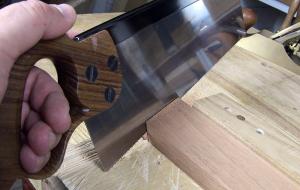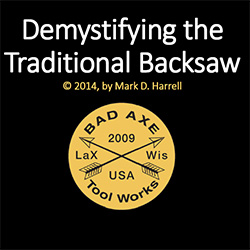Skip the Planes and Get a Saw
It’s exciting times these days because not a day goes by that I don’t get an email from someone just starting out in woodworking looking for advice. Invariably they are all a bit confused and daunted with the universe of tools presented to them to get started. Usually I get emails like this:
I have no tools and can’t really buy more than a couple planes to start where do I begin?
Which plane should I get first?
I have this plane and that plane, which plane should I get now?
It seems everyone is focused on hand planes. Maybe that is the marketplace telling them they need planes or the fact that there are many sexy looking planes out there now. This baffles me because I can think of no better place to start than with a saw. What is woodworking but taking big pieces of wood and making them smaller? Planes do this but in a destructive manner turning the board into shavings. A saw leaves you something left over and is a much quicker way of reducing a board to size.
Yes yes, planes smooth the surface and flatten the surface and they are necessary, but you have to start somewhere and mastering sawing will serve you so much better than mastering planing. Every stage of a build involves a saw and accuracy here only speeds up other tasks and sometimes even makes them unnecessary.
Stop Sneaking Up on It and Just Saw It
 The fastest way to flatten a board is with a saw (or maybe an axe). Got twist in your board? Crosscut it close to final dimension before shaving away all that precious wood. Big cup? Rip it closer to width to get a flatter board. Even if you plane your board first, you will be sawing it to size later. Accuracy here can save you hours of work later. Rather than marking a line and sawing away from it so you can sneak up on the size, a good sawyer will saw to the line and clean up the cut with a few passes of a plane.
The fastest way to flatten a board is with a saw (or maybe an axe). Got twist in your board? Crosscut it close to final dimension before shaving away all that precious wood. Big cup? Rip it closer to width to get a flatter board. Even if you plane your board first, you will be sawing it to size later. Accuracy here can save you hours of work later. Rather than marking a line and sawing away from it so you can sneak up on the size, a good sawyer will saw to the line and clean up the cut with a few passes of a plane.
Or maybe no passes with a plane. For example, would you plane the ends and edges of a panel that was slotting into a groove for a frame and panel door? Would you plane the edges of a case back only to slip it into a rabbet then slide the case up against a wall? Would you plane the cheeks and ends of a tenon only to fit it into a mortise?
Those of you nodding ask yourself, are you planing those surfaces to fit or planing them to make them look pretty. If you saw it on the line, it fits from the saw and you can often skip the whole planing thing.
Joinery Should Be Called Sawery
When was the last time you planed a joint to fit? Was that because when you sawed it you left it a bit too wide or thick? I’m struggling to think of a joint that cannot be made with a saw and struggling to think of a joint that can only be made with a plane. Even the humble rabbet can be quickly made with 2 saw cuts vs multiple passes of a rabbet plane. The dovetail actually comes together better if you only use a saw. Same with a tenon. The nice, straight saw plate when well tuned and sharp will leave a dead straight surface that splits your line. At the heart of good joints is good sawing.
“The Rest is Just Scribbling”
-WA Mozart
I do realize that chisels and planes are necessary and joinery can be tough to make when you have a board that is rough and not flat. It would be hard to make dovetails without a chisel to remove waste between pins and tails (though good sawing with a fret saw can do it). Many will tell you that the secret to any project’s success is in the milling and stock preparation. I’m not going to argue that, but when you are starting out I think the new woodworker will gain more momentum and positive reinforcement by getting a saw and working on that technique first. One can always buy S4S lumber and relative dimensioning and fitting can joint together two board snugly even if they aren’t perfectly flat.
On the converse, being able to plane a board dead flat and square on 6 faces doesn’t mean a whole lot if you can’y use a saw to join it to another board.
So which plane should you buy?
One with sharp pointy teeth.
Which saw should you buy? I don’t think it matters, just get to sawing it will make you a better woodworker. Though if pressed, I’d buy a carcass saw
Eager to Get a Saw but Facing Sticker Shock?
 Don’t overlook the thousands of vintage beauties floating around out there. Don’t be afraid of the work required to restore them. I find hand planes much more difficult to restore than a saw. Check out this outstanding guide to saw restoration that Mark Harrell at Bad Axe Toolworks put together. Truly this has everything you need to know.
Don’t overlook the thousands of vintage beauties floating around out there. Don’t be afraid of the work required to restore them. I find hand planes much more difficult to restore than a saw. Check out this outstanding guide to saw restoration that Mark Harrell at Bad Axe Toolworks put together. Truly this has everything you need to know.



